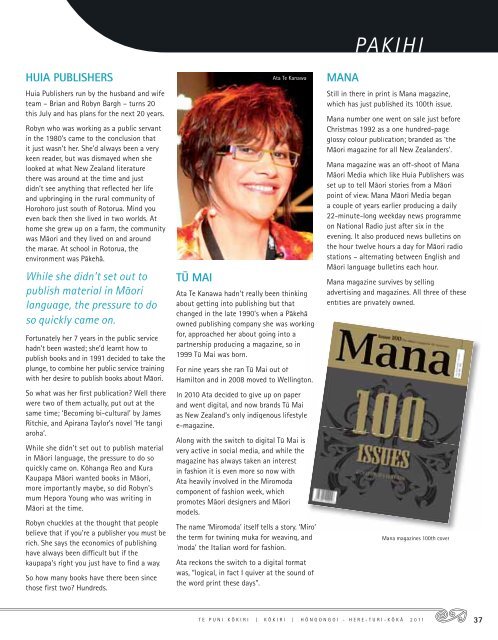Download the PDF (2.5MB) - Te Puni Kokiri
Download the PDF (2.5MB) - Te Puni Kokiri
Download the PDF (2.5MB) - Te Puni Kokiri
Create successful ePaper yourself
Turn your PDF publications into a flip-book with our unique Google optimized e-Paper software.
HUIA PUBLISHERS<br />
Huia Publishers run by <strong>the</strong> husband and wife<br />
team – Brian and Robyn Bargh – turns 20<br />
this July and has plans for <strong>the</strong> next 20 years.<br />
Robyn who was working as a public servant<br />
in <strong>the</strong> 1980’s came to <strong>the</strong> conclusion that<br />
it just wasn’t her. She’d always been a very<br />
keen reader, but was dismayed when she<br />
looked at what New Zealand literature<br />
<strong>the</strong>re was around at <strong>the</strong> time and just<br />
didn’t see anything that reflected her life<br />
and upbringing in <strong>the</strong> rural community of<br />
Horohoro just south of Rotorua. Mind you<br />
even back <strong>the</strong>n she lived in two worlds. At<br />
home she grew up on a farm, <strong>the</strong> community<br />
was Mäori and <strong>the</strong>y lived on and around<br />
<strong>the</strong> marae. At school in Rotorua, <strong>the</strong><br />
environment was Päkehä.<br />
While she didn’t set out to<br />
publish material in Mäori<br />
language, <strong>the</strong> pressure to do<br />
so quickly came on.<br />
Fortunately her 7 years in <strong>the</strong> public service<br />
hadn’t been wasted; she’d learnt how to<br />
publish books and in 1991 decided to take <strong>the</strong><br />
plunge, to combine her public service training<br />
with her desire to publish books about Mäori.<br />
So what was her first publication Well <strong>the</strong>re<br />
were two of <strong>the</strong>m actually, put out at <strong>the</strong><br />
same time; ‘Becoming bi-cultural’ by James<br />
Ritchie, and Apirana Taylor’s novel ‘He tangi<br />
aroha’.<br />
While she didn’t set out to publish material<br />
in Mäori language, <strong>the</strong> pressure to do so<br />
quickly came on. Köhanga Reo and Kura<br />
Kaupapa Mäori wanted books in Mäori,<br />
more importantly maybe, so did Robyn’s<br />
mum Hepora Young who was writing in<br />
Mäori at <strong>the</strong> time.<br />
Robyn chuckles at <strong>the</strong> thought that people<br />
believe that if you’re a publisher you must be<br />
rich. She says <strong>the</strong> economics of publishing<br />
have always been difficult but if <strong>the</strong><br />
kaupapa’s right you just have to find a way.<br />
So how many books have <strong>the</strong>re been since<br />
those first two Hundreds.<br />
TÜ MAI<br />
Ata <strong>Te</strong> Kanawa<br />
Ata <strong>Te</strong> Kanawa hadn’t really been thinking<br />
about getting into publishing but that<br />
changed in <strong>the</strong> late 1990’s when a Päkehä<br />
owned publishing company she was working<br />
for, approached her about going into a<br />
partnership producing a magazine, so in<br />
1999 Tü Mai was born.<br />
For nine years she ran Tü Mai out of<br />
Hamilton and in 2008 moved to Wellington.<br />
In 2010 Ata decided to give up on paper<br />
and went digital, and now brands Tü Mai<br />
as New Zealand’s only indigenous lifestyle<br />
e-magazine.<br />
Along with <strong>the</strong> switch to digital Tü Mai is<br />
very active in social media, and while <strong>the</strong><br />
magazine has always taken an interest<br />
in fashion it is even more so now with<br />
Ata heavily involved in <strong>the</strong> Miromoda<br />
component of fashion week, which<br />
promotes Mäori designers and Mäori<br />
models.<br />
The name ‘Miromoda’ itself tells a story. ‘Miro’<br />
<strong>the</strong> term for twining muka for weaving, and<br />
‘moda’ <strong>the</strong> Italian word for fashion.<br />
Ata reckons <strong>the</strong> switch to a digital format<br />
was, “logical, in fact I quiver at <strong>the</strong> sound of<br />
<strong>the</strong> word print <strong>the</strong>se days".<br />
MANA<br />
PAKIHI<br />
Still in <strong>the</strong>re in print is Mana magazine,<br />
which has just published its 100th issue.<br />
Mana number one went on sale just before<br />
Christmas 1992 as a one hundred-page<br />
glossy colour publication; branded as ‘<strong>the</strong><br />
Mäori magazine for all New Zealanders’.<br />
Mana magazine was an off-shoot of Mana<br />
Mäori Media which like Huia Publishers was<br />
set up to tell Mäori stories from a Mäori<br />
point of view. Mana Mäori Media began<br />
a couple of years earlier producing a daily<br />
22-minute-long weekday news programme<br />
on National Radio just after six in <strong>the</strong><br />
evening. It also produced news bulletins on<br />
<strong>the</strong> hour twelve hours a day for Mäori radio<br />
stations – alternating between English and<br />
Mäori language bulletins each hour.<br />
Mana magazine survives by selling<br />
advertising and magazines. All three of <strong>the</strong>se<br />
entities are privately owned.<br />
Mana magazines 100th cover<br />
TE PUNI KÖKIRI | KÖKIRI | HÖNGONGOI - HERE-TURI-KÖKÄ 2011<br />
37

















